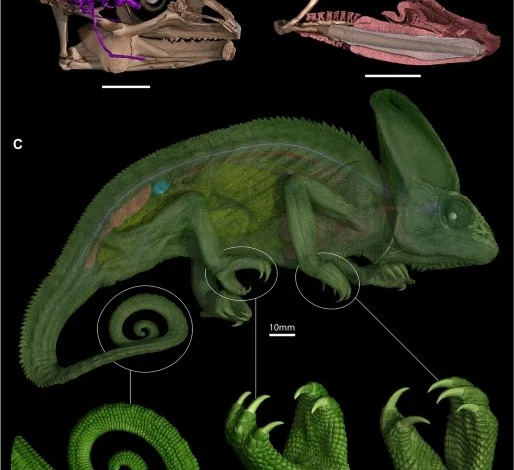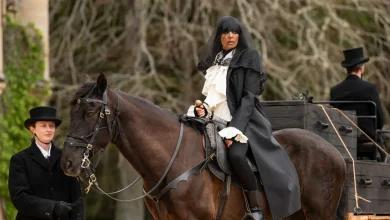A new twist in the evolution of chameleons uncovers an extremely specialized optic nerve morphology

Meiri, S. SquamBase—A database of squamate (Reptilia: Squamata) traits. Glob. Ecol. Biogeogr. 33, e13812. https://doi.org/10.1111/geb.13812 (2024).
Google Scholar
Anderson, C. & Higham, T. Chameleon anatomy. In The Biology of Chameleons (eds. Tolley, K. A. & Herrel, A.) 7–55 (University of California Press, 2014).
Owen, C. An Essay Towards a Natural History of Serpents in Two Parts (Printed for the author, sold by John Gray, 1746).
Laurenti, J. N. Specimen medicum, exhibens synopsin reptilum emendatam cum experimentis circa venena et antidota reptilum austriacorum. (Joan. Thom. Nob. de Trattnern Cæs. Reg. Aulæ Typogr. et Bibliop.,1768).
Cope, E. D. On the homologies of some of the cranial bones of the Reptilia, and on the systematic arrangement of the class. Proc. Am. Assoc. Adv. Sci. 19, 194–247 (1871).
Burbrink, F. T. et al. Interrogating Genomic-scale data for Squamata (Lizards, Snakes, and Amphisbaenians) shows no support for key traditional morphological relationships. Syst. Biol. 69, 502–520 (2019).
Google Scholar
Butler, M. A. Foraging mode of the chameleon, Bradypodion pumilum: A challenge to the sit-and-wait versus active forager paradigm?. Biol. J. Linn. Soc. 84, 797–808 (2005).
Google Scholar
Anderson, C. V. Off like a shot: scaling of ballistic tongue projection reveals extremely high performance in small chameleons. Sci. Rep. 6, 18625. https://doi.org/10.1038/srep18625 (2016).
Google Scholar
Herrel, A., Meyers, J. J., Aerts, P. & Nishikawa, K. C. Functional implications of supercontracting muscle in the chameleon tongue retractors. J. Exp. Biol. 204, 3621–3627. https://doi.org/10.1242/jeb.204.21.3621 (2001).
Google Scholar
Schneider, N. G., Henchal, N. A., Diaz, R. E. Jr. & Anderson, C. V. Feats of supercontractile strength: Functional convergence of supercontracting muscle properties among hyoid musculature in chameleons. Proc. R. Soc. B. 292, 20250078. https://doi.org/10.1098/rspb.2025.0078 (2025).
Google Scholar
Ketter-Katz, H., Lev-Ari, T. & Katzir, G. Vision in chameleons—A model for non-mammalian vertebrates. Semin. Cell Dev. Biol. 106, 94–105 (2020).
Google Scholar
Ott, M. & Schaeffel, F. A negatively powered lens in the chameleon. Nature 373, 692–694. https://doi.org/10.1038/373692a0 (1995).
Google Scholar
Ott, M., Schaeffel, F. & Kirmse, W. Binocular vision and accommodation in prey-catching chameleons. J. Comp. Physiol. A. 182, 319–330 (1998).
Google Scholar
Lev-Ari, T., Ketter-Katz, H., Lustig, A. & Katzir, G. Visual acuity and optokinetic directionality in the common chameleon (Chamaeleo chamaeleon). EC Ophtalmol. 6(5), 145–154 (2017).
Paré, A. Deux livres de chirurgie, I. De la generation de l’homme, et maniere d’extraire les enfans hors du ventre de la mere, ensemble ce qu’il faut faire pour la faire mieux, et plus tost accoucher, avec la cure de plusieurs maladies qui luy peuvent survenir. 2. Des monstres tant terrestres que marins, avec leurs portrait. Plus un petit traité des plaies faites aux parties nerveuses. (André Wechel, 1573).
Pettigrew, D., Collin Shaun, P. & Ott, M. Convergence of specialized behavior, eye movements and visual optics in the sandlance (Teleostei) and the chameleon (Reptilia). Curr. Biol. 9, 421–424 (1999).
Land, M. F., Marshall, J. N., Brownless, D. & Cronin, T. W. The eye-movements of the mantis shrimp Odontodactylus scyllarus (Crustacea: Stomatopoda). J. Comp. Physiol. A 167, 155–166 (1990).
Google Scholar
Cronin, T. W. & Porter, M. L. Exceptional variation on a common theme: The evolution of crustacean compound eyes. Evol. Educ. Outr. 1, 463–475. https://doi.org/10.1007/s12052-008-0085-0 (2008).
Google Scholar
Fritsches, K. & Marshall, N. Independent and conjugate eye movements during optokinesis in teleost fish. J. Exp. Biol. 205, 1241–1252. https://doi.org/10.1242/jeb.205.9.1241 (2002).
Google Scholar
Yorzinski, J. Great-tailed grackles can independently direct their eyes toward different targets. Exp. Brain Res. 239, 2119–2126 (2021).
Google Scholar
Thomas, R. A new anole (Sauria: Iguanidae) from Puerto Rico. Part II. Field observations on Anolis occultus Williams and Rivero. Breviora 231, 10–18 (1965).
Williams, E. E. & Rivero, J. A. A new anole (Sauria: Iguanidae) from Puerto Rico. Part I. Description. Breviora 231, 1–9 (1965).
Schwartz, A. & Henderson, R. W. Amphibians and Reptiles of the West Indies. Descriptions, Distributions and Natural History (University of Florida Press, 1991).
Ketter-Katz, H. et al. Eye movements in chameleons are not truly independent – evidence from simultaneous monocular tracking of two targets. J. Exp. Biol. 218, 2097–2105 (2015).
Google Scholar
Ott, M. Chameleons have independent eye movements but synchronize both eyes during saccadic prey tracking. Exp. Brain Res. 139, 173–179. https://doi.org/10.1007/s002210100774 (2001).
Google Scholar
Gisi, M. J. Das Gehirn von Hatteria punctata. Ph.D. Dissertation, Universität Basel, iv + 166 pp + 1 (1907).
Paulina-Carabajal, A. et al. A look in to the neurocranium of living and extinct Lepidosauria. In Paleoneurology of Amniotes, New Directions in the Study of Fossil Endocasts (eds. M. T. Dozo, A Paulina-Carvajal, T.E. Macrini, & S. Walsh) 123–178 (Springer, 2023).
Shanklin, W. M. The central nervous system of Chameleon vulgaris. Acta Zool. 11, 425–490 (1930).
Google Scholar
Fischer, J. G. Die Gehirnnerven der Saurier anatomisch untersucht (J.A. Meissner, 1852).
Diaz, R. E. Jr., Shylo, N. A., Roellig, D., Bronner, M. & Trainor, P. A. Filling in the phylogenetic gaps: Induction, migration, and differentiation of neural crest cells in a squamate reptile, the veiled chameleon. Dev. Dynam. 248, 709–727. https://doi.org/10.1002/dvdy.38 (2019).
Google Scholar
Gross, J. Ueber die Sehnervenkreuzung bei den Reptilien. Zool. Jahrb. 17, 763–799 (1903).
Jeffery, G. PNS features of rodent optic nerve axons. J. Comp. Neurol. 366, 370–378 (1996).
Google Scholar
Fontana, M. Traité sur le vénin de la vipere sur les poisons Americains sur le Laurier-Cerise et sur quelques autres poisons vegetaux. On y a joint des observations sur la structure primitive du corps animal. Différentes experiences sur la reproduction des nerfs et la description d’un nouveau canal de l’oeil, vol 2. (No publisher listed, 1781).
Aristotle. Aristotelis de natura animalium libri novem, de partibus animalium libri quattuor: de generatione animalium libri quin. Interprete Theodoro Gaza (Iohannes & Gregorius de Gregoriis Frattres, 1492).
Newton, I. Opticks: Or, a treatise of the reflexions, refractions, inflexions and colours of light. Also two treatises of the species and magnitude of curvilinear figures. [iv] + 144 + 211 + [1], 18 pls. (Sam. Smith, and Benj. Walford, 1704).
Perrault, C. Description anatomique d’un cameleon, d’un castor, d’un dromadaire, d’un ours, et d’une gazelle. (Frederic Leonard, 1669).
Vallisnieri, A. Istoria del camaleonte affricano, e di varj animali d’Italia. (Gio. Gabbriello Ertz, 1715).
Panaroli, D. Il Chamaleonte esaminato. (Francesco Cavalli, 1645).
Briggs, W. 3. A continuation of a discourse about vision, with an examination of some late objections against it. Philos. Trans. R. Soc. 13, 171–182 (1683).
Tidhar, L.-A. Visual acuity and visually guided avoidance behavior in the common chameleon (Chamaeleo chameleon) M. A. thesis, University of Haifa (Israel), viii + 49 pp + 2 (2014).
Bennis, M. et al. A quantitative ultrastructural study of the optic nerve of the chameleon. Brain. Behav. Evol. 58, 49–60 (2001).
Google Scholar
Nava, S. S., Conway, M. A. & Martins, E. P. Divergence of visual motion detection in diurnal geckos that inhabit bright and dark habitats. Funct. Ecol. 23, 794–799. https://doi.org/10.1111/J.1365-2435.2009.01565.X (2009).
Google Scholar
Fleishman, L. J. The influence of the sensory system and the environment on motion patterns in the visual displays of anoline lizards and other vertebrates. Am. Nat. 139, S36–S61. https://doi.org/10.1086/285304 (1992).
Google Scholar
Regalado, R. Social behavior of dwarf geckos (Sphaerodactylus): a comparative repertoire. Ethol. Ecol. Evol. 24, 344–366. https://doi.org/10.1080/03949370.2012.702685 (2012).
Google Scholar
Hedges, S. B. & Thomas, R. At the lower size limit in amniote vertebrates: a new diminutive lizard from the West Indies. Caribb. J. Sci. 37, 168–173 (2001).
Thomas, R. A new gecko from the Virgin Islands. Q. J. Florida Acad. Sci. 28, 117–122 (1965).
Röll, B. Gecko vision–retinal organization, foveae and implications for binocular vision. Vision Res. 41, 2043–2056 (2001).
Google Scholar
Evans, L., Hardtke, F., Corbin, E. & Claes, W. Camouflaged chameleons: a new discovery at the Egyptian site of el-Hosh. Archael. Antropol. Sci. 12, 158. https://doi.org/10.1007/s12520-020-01125-y (2020).
Google Scholar
Albertus Magnus. Divi Alberti Magni de animalibus libri vigintisex novissime impressi (Joannem et Gregorius de Gregoriis, 1495).
Pliny the Elder. Naturalis Historia. (Spira loannes [Joanis de Spira], 1469).
Solinus, C. Iulii Solini De Situ Orbis Terrarum, et Memorabilibus quæ Mundi Ambitu Continentur, Liber. (Impressus per Nicolaum lenson Gallicum, 1473).
Bennis, M., Repérant, J., Rio, J.-P. & Ward, R. An experimental re-evaluation of the primary visual system of the European chameleon, Chamaeleo chameleon. Brain. Behav. Evol. 43, 173–188 (1994).
Google Scholar
Huber, G. C. & Crosby, E. C. On thalamic and tectal nuclei and fiber paths in the brain of the American alligator. J. Comp. Neurol. 40, 97–227 (1926).
Google Scholar
Mitra, A. T. et al. Ocular lens morphology is influenced by ecology and metamorphosis in frogs and toads. Proc. R. Soc. B. 289, 20220767. https://doi.org/10.1098/rspb.2022.0767 (2022).
Google Scholar
Currea, J. P., Sondhi, Y., Kawahara, A. Y. & Theobald, J. Measuring compound eye optics with microscope and microCT images. Comm. Biol. 6, 246. https://doi.org/10.1038/s42003-023-04575-x (2023).
Google Scholar
Sumner-Rooney, L., Kenny, N. J., Ahmed, F. & Williams, S. T. The utility of micro-computed tomography for the non-destructive study of eye microstructure in snails. Sci. Rep. 9, 15411. https://doi.org/10.1038/s41598-019-51909-z (2019).
Google Scholar
Sándor, P., Frens, M. & Henn, V. Chameleon eye position obeys Listing’s law. Vis. Res. 41, 2245–2251 (2001).
Google Scholar
Tweed, D. & Vilis, T. Geometric relations of eye position and velocity vectors during saccades. Vision Res. 30, 111–127 (1990).
Google Scholar
Čerňanský, A. et al. The only complete articulated early Miocene chameleon skull (Rusinga Island, Kenya) suggests an African origin for Madagascar’s endemic chameleons. Sci. Rep. 10, 109. https://doi.org/10.1038/s41598-41019-57014-41595 (2020).
Google Scholar
Bolet, A. & Evans, S. E. In The Biology of Chameleons (eds. Tolley K. A. & Herrel A.) 175–192 (University of California Press, 2013).
Vidal, N. & Hedges, S. B. The molecular evolutionary tree of lizards, snakes, and amphisbaenians. C. R. Biol. 332, 129–139 (2009).
Google Scholar
Jones, M. E. et al. Integration of molecules and new fossils supports a Triassic origin for Lepidosauria (lizards, snakes, and tuatara). BMC Evol. Biol. 13, 208 (2013).
Google Scholar
Kumar, S. et al. TimeTree 5: an expanded resource for species divergence times. Mol. Biol. Evol. https://doi.org/10.1093/molbev/msac174 (2022).
Google Scholar
Sieradzki, A. Designed for darkness—The unique physiology and anatomy of owls. In Owls—Clever Survivors (ed. Mikkola, H.) 1–19 (IntechOpen, 2022).
Steinbach, M. J. & Money, K. E. Eye movements of the owl. Vision Res. 13, 889–891 (1973).
Google Scholar
Money, K. E. & Correia, M. J. The vestibular system of the owl. Comp. Biochem. Physiol. A. 42, 353–358 (1972).
Google Scholar
Krings, M., Nyakatura, J. A., Boumans, M., Fischer, M. S. & Wagner, H. Barn owls maximize head rotations by a combination of yawing and rolling in functionally diverse regions of the neck. J. Anat. 231, 12–22. https://doi.org/10.1111/joa.12616 (2017).
Google Scholar
Molnar, J. & Watanabe, A. Morphological and functional regionalization of trunk vertebrae as an adaptation for arboreal locomotion in chameleons. R. Soc. Open. Sci. 10, 221509. https://doi.org/10.1098/rsos.221509 (2023).
Google Scholar
Micheti, E. Il Camaleonte Anatomizato. 31 pp., 3 pls. (Gio. Giacomo Komarek, 1699).
Schwaner, S. A., Feola, A. J. & Ethier, C. R. Factors affecting optic nerve head biomechanics in a rat model of glaucoma. J. R. Soc. Interface 17, 20190695. https://doi.org/10.1098/rsif.2019.0695 (2020).
Google Scholar
Beebe, W. New data on the deep sea fish Stylophthalmus and Idiacanthus. Science 78, 390–390 (1933).
Google Scholar
Beebe, W. Deep-sea fishes of the Bermuda Oceanographic Expeditions. Family Idiacanthidae. Zoologica 16, 148–241 (1934).
Buschbeck, E. K. & Hoy, R. R. The development of a long, coiled, optic nerve in the stalk-eyed fly Cyrtodiopsis whitei. Cell Tissue Res. 321, 491–504 (2005).
Google Scholar
Gignac, P. M. et al. Diffusible iodine-based contrast-enhanced computed tomography (diceCT): an emerging tool for rapid, high-resolution, 3-D imaging of metazoan soft tissues. J. Anat. 228, 889–909. https://doi.org/10.1111/joa.12449 (2016).
Google Scholar
Blackburn, D. C. et al. Increasing the impact of vertebrate scientific collections through 3D imaging: The openVertebrate (oVert) Thematic Collections Network. Bioscience 74, 169–186. https://doi.org/10.1093/biosci/biad120 (2024).
Google Scholar
Collin, S. P. et al. Bioimaging of sense organs and the central nervous system in extant fishes and reptiles in situ: A review. Anat. Rec. https://doi.org/10.1002/ar.25566 (2024).
Google Scholar
Tonini, J. F. R., Beard, K. H., Ferreira, R. B., Jetz, W. & Pyron, R. A. Fully-sampled phylogenies of squamates reveal evolutionary patterns in threat status. Biol. Conserv. 204, 23–31 (2016).
Google Scholar
Diaz, R. E. et al. Captive care, raising, and breeding of the veiled chameleon (Chamaeleo calyptratus). Cold Spring Harb. Protoc. 2015, 943–949 (2015).
Conroy, C. J., Papenfuss, T., Parker, J., Hahn, N. E. Use of tricaine methanesulfonate (MS222) for euthanasia of reptiles. J. Am.Assoc. Lab. Animal Sci. 48, 28–32 (2009).
Jr Diaz, R. E., Bertocchini, F., Trainor P. A. Lifting the veil on reptile embryology: The veiled chameleon (Chamaeleocalyptratus) as a model system to study reptilian development Meth. Mol. Biol 1650, 269–284 (2017).





